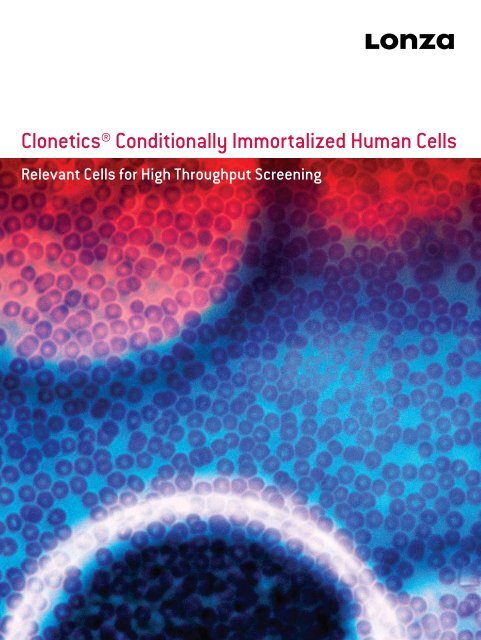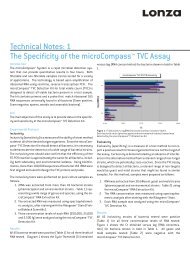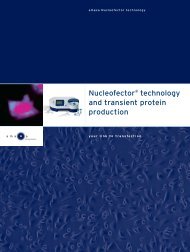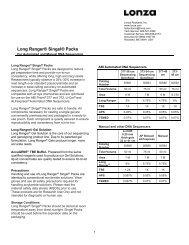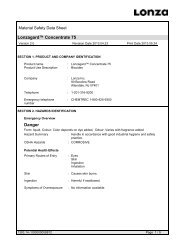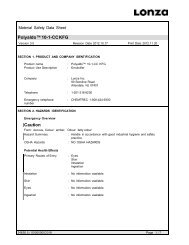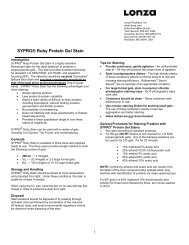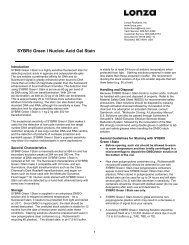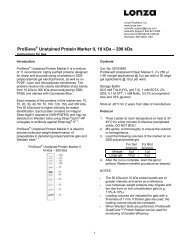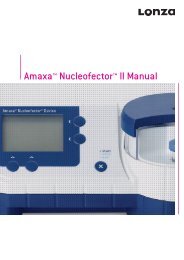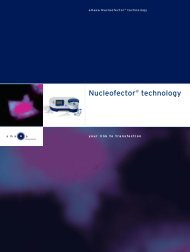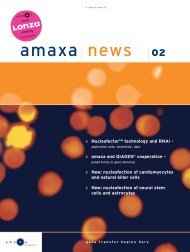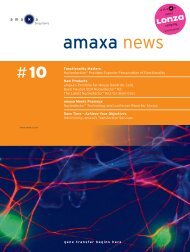Clonetics® Conditionally Immortalized Human Cells - Lonza
Clonetics® Conditionally Immortalized Human Cells - Lonza
Clonetics® Conditionally Immortalized Human Cells - Lonza
You also want an ePaper? Increase the reach of your titles
YUMPU automatically turns print PDFs into web optimized ePapers that Google loves.
<strong>Clonetics®</strong> <strong>Conditionally</strong> <strong>Immortalized</strong> <strong>Human</strong> <strong>Cells</strong><br />
Relevant <strong>Cells</strong> for High Throughput Screening
<strong>Clonetics®</strong> <strong>Conditionally</strong> <strong>Immortalized</strong> <strong>Cells</strong><br />
<strong>Clonetics®</strong> <strong>Conditionally</strong> <strong>Immortalized</strong> Cell Strains<br />
<strong>Conditionally</strong> immortalized cell strains are primary cells that<br />
behave normally in cell culture, can be expanded beyond 40 population<br />
doublings, yet maintain normal behaviors throughout the culture<br />
time. This powerful breakthrough is achieved by combining the<br />
telomere rejuvenating effects of telomerase with a specially<br />
modified temperature sensitive large-T (ts LT) antigen in the same cell.<br />
The ts LT mutant drives cell proliferation while controlling the classical<br />
behaviors of SV40 that impact karyotypic stability over multiple<br />
population doublings. Consequently, the conditionally immortalized cell<br />
strain acts like a primary cell, provides homogeneous cell populations<br />
at the high cell counts of cell lines, and allows researchers to eliminate<br />
poor drug candidates early to focus on more promising candidates.<br />
1
<strong>Clonetics®</strong> <strong>Conditionally</strong> <strong>Immortalized</strong> <strong>Cells</strong><br />
2<br />
23%<br />
Clinical Ecacy<br />
Portfolio Reasons<br />
Clinical Safety<br />
Toxicity<br />
ADME<br />
20% 12%<br />
22%<br />
23%<br />
The Problem Today<br />
It takes years to develop a drug candidate into a commercially available<br />
product; consequently, the most promising compounds need to be<br />
identified early. Twenty-two percent of new drugs fail due to efficacy. The<br />
drug discovery teams need to be confident, early on, that they are investing<br />
development time in the best candidates with the highest probability of<br />
surviving the clinical trials gauntlet. The pharmaceutical organizations<br />
that don’t do this successfully, fail.<br />
Figure 1. Five reasons why drug candidates fail in clinical trials.<br />
Twenty-two percent of new drugs fail due to efficacy. Poor efficacy could be identified early by using<br />
normal human cells.<br />
Limitations of Today’s Tools<br />
Live animal models yield a rich supply of data, but are not cost effective for<br />
high throughput screening. One must also engage in species extrapolation<br />
to reach a best guess of how the drug will work on humans.<br />
Cell lines provide the high cell count and homogeneous populations for<br />
high throughput applications, but don’t exhibit normal behavior, as do<br />
primary cells.<br />
It is well accepted that primary cells behave more normally than cell<br />
lines. Yet, key limitations exist that preclude one from using primary cells<br />
during initial phases of drug screening. The limitations include cost,<br />
homogeneity of cell population and total cell count achievable, donor<br />
to donor variability, and loss of key cellular behaviors when the cell is<br />
outside its home organ.
<strong>Clonetics®</strong> <strong>Conditionally</strong> <strong>Immortalized</strong> <strong>Cells</strong><br />
33°C<br />
37°C<br />
pRb E2<br />
pRb<br />
Ts T Antigen<br />
F<br />
E2F<br />
pRb E2<br />
Cell Division Blocked<br />
pRb<br />
Ts T Antigen<br />
Proliferation<br />
S Phase<br />
Proliferation<br />
S Phase<br />
Figure 2. Temperature sensitive T antigen.<br />
Using temperature sensitive T antigen, we can “switch off” the proliferation by a simple change in<br />
temperature.<br />
E2F<br />
Chromosome Telomere Repeats<br />
F<br />
Telomerase<br />
Telomerase<br />
Telomerase<br />
Figure 3. Telomerase activity in normal cells.<br />
Addition of telomerase to a somatic cell can lengthen telomeres, allowing cell division.<br />
Each time cell divides, the<br />
telomeres become shorter<br />
When telomeres shorten,<br />
chromosomes become<br />
unstable and cell division<br />
is blocked<br />
Telomerase can extend<br />
telomeres and allow<br />
continuation of cell division<br />
Conditional Immortalization – The Breakthrough!<br />
Temperature sensitive large-T (ts LT)<br />
Our construct of a specially modified ts LT drives cells to proliferate for<br />
many population doublings, can be switched off to allow the cells to<br />
differentiate under the proper media conditions, and confers stability to<br />
the host genomic background.<br />
The ts LT mutant codes for a gene product that is functional at 33°C, but<br />
non-functional at 37°C. Though the construct overcomes the cells’ natural<br />
senescence behavior at low passage and provides a strong proliferative<br />
signal, the cells are not able to exhibit a full range of differentiated<br />
functions. By switching the culture conditions to 37°C, one stops cell<br />
proliferation and the cells are responsive to media growth factors that<br />
drive differentiation. If the line is carried at 37°C for sufficient time, the<br />
strain permanently looses its ability to proliferate. A second mutation<br />
in the construct controls SV40’s ability to auto-excise. Consequently,<br />
this mutant conveys a higher level of karyotype stability to the host<br />
genomic background.<br />
Telomerase<br />
Telomerase provides chromosomal stability over multiple cell division<br />
events. During mitosis, cells make copies of their genetic material. To make<br />
sure that information is successfully passed from one generation to the<br />
next, each chromosome has a special protective cap of a (TTAGGG) repeat<br />
sequence called a telomere located at the end of its “arms”. Telomeres<br />
can reach a length of 15,000 base pairs and function by preventing<br />
chromosomes from losing base pair sequences at their ends. They also stop<br />
chromosomes from fusing to each other. However, each time a cell divides,<br />
some of the telomere is lost (usually 25 – 200 base pairs per division).<br />
When the telomere becomes too short, the chromosome reaches<br />
a “critical length” and can no longer replicate. At this point, cells<br />
senesce and may eventually be removed by apoptosis. Telomere<br />
activity is controlled by two mechanisms: erosion and addition.<br />
Erosion, as mentioned, occurs each time a cell divides. Addition<br />
is determined by the activity of telomerase.<br />
Telomerase, also called telomere terminal transferase, is an<br />
enzyme made of protein and RNA subunits that elongates<br />
chromosomes by adding TTAGGG sequences to the end of existing<br />
chromosomes. Telomerase is found in fetal tissues, adult germ<br />
cells, and tumor cells. Telomerase activity is regulated during<br />
development and has a very low, almost undetectable, activity in<br />
somatic (body) cells. Since these somatic cells do not regularly<br />
use telomerase, they age. If telomerase is activated in a cell,<br />
the cell will continue to grow and divide; consequently, active<br />
telomerase is critical to avoid senescence and generate billions<br />
of daughter cells for high throughput screening.<br />
3
<strong>Clonetics®</strong> <strong>Conditionally</strong> <strong>Immortalized</strong> <strong>Cells</strong><br />
The Power of the Combination<br />
Sequential transfection at low passage using ts LT, followed by telomerase,<br />
is critical to yielding the most prolific strains, highly responsive<br />
to differentiation.<br />
Fig. 4. Retroviral transduction with ts LT and hTERT.<br />
Sequence of retroviral gene transduction and resulting population-doubling (PD) potential of human<br />
adult mammary fibroblasts from a single 19-year-old donor (HMF3).<br />
4<br />
ts LT @ p4<br />
HMF3A<br />
p64 = 195 PD<br />
HMF3B<br />
p56 = 147 PD<br />
HMF3<br />
HMF3C<br />
p55 = 170 PD<br />
hTERT @ p4<br />
hTERT @ p6 ts LT @ p6<br />
ts LT @ p12 hTERT @ p12<br />
x<br />
hTERT @ p18 p18 = 45 PD ts LT @ p17<br />
x<br />
x<br />
p18 = 49 PD<br />
p20 = 54 PD<br />
x<br />
x<br />
p24 = 64 PD<br />
p25 = 66 PD<br />
Split ratio 1:4<br />
Split ratio 1:10 / 1:20<br />
HMF3D<br />
p68 = 252 PD<br />
References<br />
Fauth, C., O’Hare, M. J., Lederer, G., Jat, P. S., and Speicher, M. R. (2004)<br />
Order of genetic events is critical determinant of aberrations in chromosome count and structure.<br />
Genes, Chromosomes & Cancer 40: 298–306<br />
O’Hare, M. J., Bond, J., Clarke, C., Takeuchi, Y., Atherton A. J., Berry, C. (2001)<br />
Conditional immortalization of freshly isolated human mammary fibroblasts and endothelial cells.<br />
PNAS 98: 646–651<br />
37°C – Normal Phenotype<br />
<strong>Cells</strong> isolated from<br />
human tissues<br />
Transfect with<br />
Large T-antigen<br />
<strong>Cells</strong> are created<br />
expressing temperature<br />
sensitive Large T-antigen<br />
and telomerase<br />
33°C – Large T-antigen Active<br />
<strong>Immortalized</strong> Phenotype<br />
(gene expression altered)<br />
Cell population<br />
expanded due to<br />
immortalization<br />
37°C – Normal phenotype<br />
<strong>Cells</strong> revert to a<br />
normal phenotype<br />
Figure 5. How conditional immortalization works.<br />
Immortalization<br />
Switched ON<br />
Immortalization<br />
Switched OFF<br />
Normal <strong>Cells</strong> for HTS and Drug Discovery<br />
By combining the proliferation driving power of ts LT and telomerase to<br />
manage cellular senescence, one achieves conditional immortalization.<br />
Conditional immortalization allows, at a permissive temperature, production<br />
of large, uniform cell populations. At this permissive temperature,<br />
telomerase is actively reversing telomere shortening, as daughter cells<br />
are spawned. Concurrently, at the permissive temperature, the special ts LT<br />
is actively driving cell proliferation while maintaining karyotype stability<br />
over 40+ population doublings. By increasing the culture temperature,<br />
the cells stop dividing. One then converts to a differentiation medium, so<br />
that the cells can express normal differentiated function and phenotype<br />
once again.<br />
Now drug discovery researchers have access to an unlimited supply of<br />
differentiated cells of the same genotype that can be used as models in<br />
drug discovery programs for functional cell-based assays and long-term<br />
gene expression studies.
Contact Information<br />
Contact Information<br />
North America<br />
Customer Service: 800-638-8174<br />
Technical Service: 800-521-0390<br />
E-mail: biotechserv@lonza.com<br />
Online Ordering: www.lonza.com<br />
Europe<br />
Customer Service: 32 (0) 87 321 611<br />
Technical Service: 32 (0) 87 321 611<br />
E-mail: techsup.europe@lonza.com<br />
or techsup.uk@lonza.com<br />
Online Ordering: www.lonza.com<br />
International<br />
Contact your local <strong>Lonza</strong> Distributor<br />
Customer Service: 301-898-7025, ext. 2322<br />
Fax: 301-845-8291<br />
E-mail: biotechserv@lonza.com<br />
International Offices<br />
Australia 61 3 9550 0883<br />
Austria 0800 201 538<br />
Belgium 32 (0) 87 321 611<br />
Denmark 45 43 56 74 07<br />
France 0800 91 19 81<br />
Germany 0800 182 52 87<br />
India 91 22 6697 2883<br />
Italy 39 0363 35 14 70<br />
The Netherlands 0800 022 4525<br />
Spain 34 902 531 366<br />
Switzerland 0800 83 86 20<br />
United Kingdom 44 118 979 5234<br />
<strong>Lonza</strong> Walkersville, Inc.<br />
Walkersville, MD 21793<br />
For Research Use Only. Not for use in diagnostic procedures.<br />
Unless otherwise noted, all trademarks herein are marks of the <strong>Lonza</strong> Group or its affiliates.<br />
© Copyright 2007, <strong>Lonza</strong> Walkersville, Inc. All rights reserved.<br />
FL-CCIC 08/07


